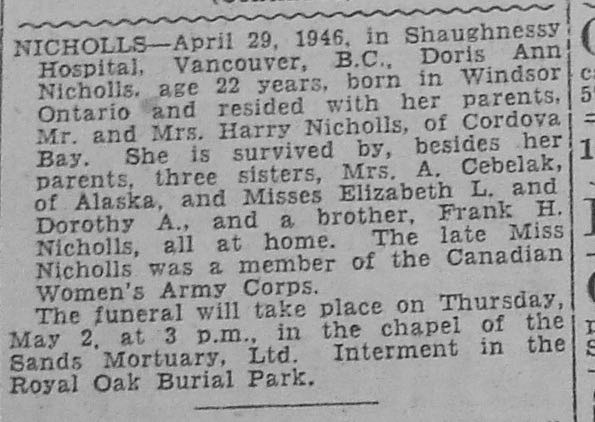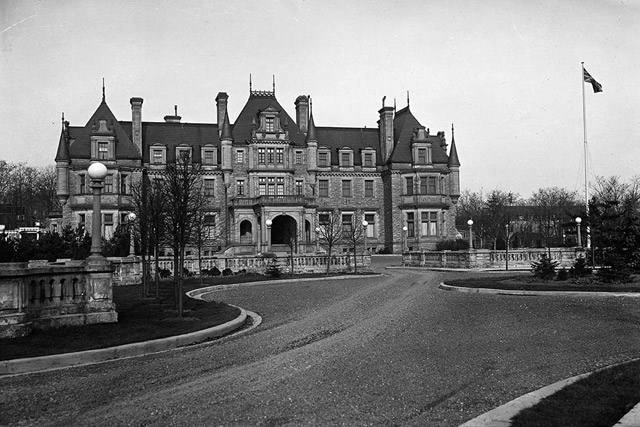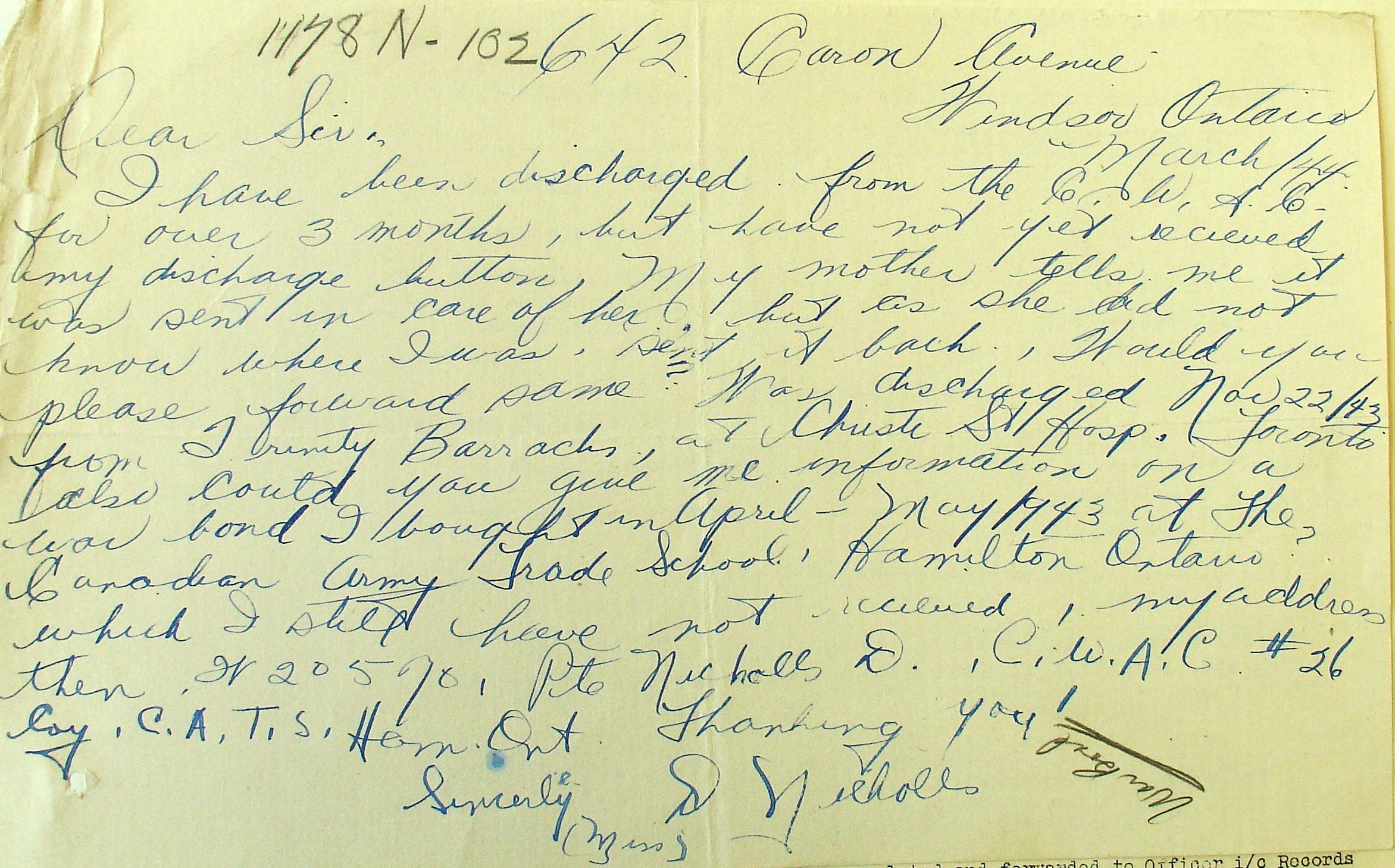


December 9, 1923 - April 29, 1946



Born in Windsor, Ontario, Doris Ann Nicholls was the daughter of Harry and Kathleen (nee Witt) Nicholls later of Newtonbrook, a suburb of Toronto (1942) and Cordova Bay, British Columbia (1946). Both parents were originally from England. Doris had one brother, Frank, who was in the Army, plus three sisters, Rose, Elizabeth and Dorothy. The family attended the United Church.
Doris stood 5' 2" tall, weighed 115 pounds, had blue eyes and auburn hair. She had a scar on the right side of her forehead, possibly the result of having been in a car accident, missing school for a year. She finished Grade 8 (partially) at Newtonbrook at the age of 16.
Doris had worked as a waitress in Toronto and also at the Maple Leaf restaurant in Windsor, Ontario, over a two year period. She also worked in a factory for two months, but she found it too noisy. She belonged to the Women's Land Brigade for 8 months, then left to enlist on November 16, 1942 in Toronto.
On her PERSONNEL SELECTION RECORD compiled by Lt. Patricia Blair: "She stopped school as she didn't like it and wanted to get a job. Received Basic Training at Kitchener, Ontario. Was posted to No. 26 Coy., Hamilton, as waitress in Sergeants' Mess. Has been there four months." OTHER PERSONAL HISTORY AND APPRAISAL: Mother is living in Newtonbrook. Father at present doing war work in Sarnia. One brother -- with Army overseas -- three sisters -- one married; two at school. Interests: enjoys sports, movies, reading (adventure and library books), collected coins and hat badges. Belonged to the YPS and Girl Guides. This is a girl with reddish brown hair, full lips -- was quiet and polite during the interview. 'M' score is low average. She likes the camp. Girl is suited to her present duties as waitress. RECOMMENDATION: Continue present duties as waitress."
Pte Nicholls was admitted to Chorley Park Military Hospital, Toronto, in mid-June 1943. "My voice is weak and I have difficulty in swallowing. I cannot open my eyes wide and sometimes have double vision. My hands and arms were quite weak, but are stronger now. I think my voice becomes weaker after talking for awhile. I have occasional headaches. My appetite is fair." The doctor assessed her. "Small, slight young woman. Not acutely ill. Markedly weak and nasal voice. Cheerful, cooperative, and intelligent. Loss of ability to whistle and sing." By August 7, 1943: "Some improvement in swallowing on discharge, but nasal speech persisted and occasional difficulty in swallowing continued. Remained unable to whistle, frown, or open eyes widely." September 20, 1943: "Noticed weakness of arms and hands and some weakness of knees. Double vision returned and lasted about 10 days. Loss of about 20 pounds weight in the past year. Some improvement since admission October 8, 1943." It was indefinite for how long Pte. Nicholls would experience these symptoms. .
On October 8, 1943, Dr. George Boyer wrote a letter to Col. Frank Hassard at Chorley Park: "At the present time, she undoubtedly has well-marked bulbar signs. She has little soft-palate movement at all. Water regugitates into her nose when she drinks. Her tongue is strophic and weak. She cannot completely close her eyes. Her face lacks detail and expression. Her hand grips, and indeed the whole upper limb, is weak on both sides. The deep reflexes in her knees and ankles are easily obtained. The plantar reflexes are flexor. Her corneal reflexes are equal. Sentation on the face is equal. Both optic discs are suggestive of intracranial pressure, although one would have to see them on different occasions to definitely state that they were pathological. She complains of diplopia at times, although I did not demonstrate squint today. This patient in my opinion should not be on duty. I am not familiar with the findings of the spinal puncture in June, but if the condition is progressing as she feels that it is, I am afraid that she may be developing something in the nature of a neoplasm."
On October 19, 1943 at Christie Street Hospital, another assessment was made of Pte Doris Ann Nicholls. "In December 1942, she was very ill for two weeks with a very sore throat." Her state of health was reviewed. "At present, complaints are that of difficulty in talking, early fatigue, some weakness in both wrists, slight difficulty in swallowing and rather frequent frontal headaches...the diagnosis of this case is difficult. The clinical signs indicate involvement of motor function only, in the 7th, 9th, 10th, and 12th cranial nerves...there have been some remission in symptoms during the spring and there has been a variability in intensity of the symptoms since June. The outstanding complaint throughout the illness has been fatigue and examination at the present time suggests a bilaterally symptomatic muscular lesion, rather than a lesion resulting from involvement of the brain stem...the diagnosis in this case should be myasthenia gravia. This young woman is medically unfit and I would suggest that she be discharged from the army, category "E" and transferred to the Department of Pensions and National Health for treatment." Dr. W. W. Barraclough, Neurologist
Myasthenia gravia is a chronic auto-immune neuromuscular disease caused by a breakdown in the normal communication between nerves and muscles. There is no cure. This disease is common in women younger than 40 and men over 60.
In March 1944, Doris wrote a letter from her parents' home in Windsor, Ontario. "Dear Sir, I have been discharged from the CWAC for over three months, but have not yet received my discharge button. My mother tells me it was sent in the care of her, but as she did not know where I was, sent it back. Would you please forward same? I was discharged November 22, 1943 from Trinity Barracks at Christie Street Hospital, Toronto. Also, could you give me information on a war bond I bought in April-May 1943 at the Canadian Army Trade School, Hamilton, Ontario, which I still have not received. My address then: W20570, Pte Nicholls, D. CWAC, No. 26 Coy. CATS, Hamilton, Ontario. Thanking you, Sincerely, (Miss) D. Nicholls"
By July 1944, Doris was in British Columbia.
In November 1944, from Cordova Bay, BC, Doris wrote in regard to her service gratuity reminding the Director of Records that she wrote to them about two months prior about it and had not received a reply. A letter from September 24, 1944 was on file. "Have since been in hospital and am expecting to leave here in five or six weeks. Will be unable to work for sometime and this money ($7.50/month) will certainly be of use. Have been informed I have this coming to me, so would greatly appreciate you sending me correct information."
From the Shaughnessey Hospital, Vancouver, in November 1945, Doris wrote, "Dear Sir, regarding the loss of my discharge pin, would like to know if you could possibly send me a new one. Said pin was left at the home of Mrs. Anthony Cebelack, Cordova Bay. Upon writing to ask her to forward it on to me, I find she has dumped contents of suitcase without my permission to use it for herself, with the result my pin has been lost. Have written and asked her to make a thorough search, but received no reply to my letter. As I must have this pin for obvious reasons, would appreciate it very much if you would assist me on this matter. I have spent most of my time in hospital since coming here last year from my home in Toronto, Ontario, and expect to be here for sometime yet, so there is little I can do...Your earliest attention on this matter would be greatly appreciated."
By December 13, 1945, Doris was still at Shaughnessy Hospital in Vancouver as a patient. She was again inquiring about her War Service Badge, "General Service Class." "Lost to me on June 1945, left at the home of Mrs. Cebelack, Cordova Bay, who destroyed the contents of suitcase. I have written several times and received no reply. Am patient in hospital. I believe it lost." Mrs. Cebelak was one of her sisters.
On April 29, 1946, Doris Ann Nicholls died at the Shaughnessey Hospital in Vancouver. A funeral was held for her on May 2, 1946. Her remains were interred at the Royal Oak Burial Park, Victoria, BC.
LINKS: